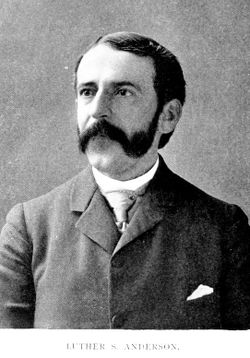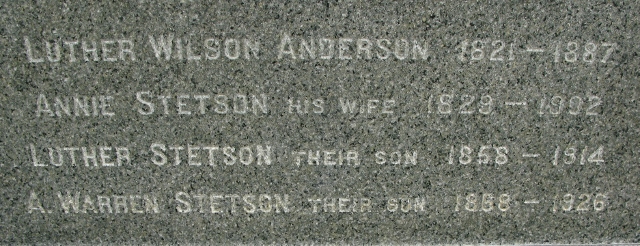In 1875 he was enrolled as a student at Adams Academy, where he was graduated in 1878; and in 1882 he was graduated from Harvard College, Magna Cum Laude. In September of that year he secured a situation in the general freight office of the Old Colony Railway, where he worked in various capacities for three years.
The following entry is from the Baccalaureate Sermon, Class Day Oration, Etc – Harvard College (1780- ). Class of 1882:
LUTHER STETSON ANDERSON. "After the usual summer vacation I entered the General Freight Department of the Old Colony Railroad and have since remained in the employ of that Corporation, learning the business in all its branches. Very naturally, owing to the soulless nature of Railroad Corporations, the vacations, and consequently the travels, have been rather few and far between. It is quite probable that at no distant day I shall be called upon to abandon New England for the West, a change which, although pleasant in some respects, will not be particularly fascinating to a dyed- in-the-wool Yankee."
UNION PACIFIC RAILROAD — Congress distrusted the Union Pacific Railroad and in 1884 forced it to hire Charles Francis Adams Jr. as the new president. On September 30, 1885, Adams hired Mr. Anderson as his assistant and in addition to that, on April 30, 1888, he was made assistant treasurer of the company, and in the month of June, 1889, was also appointed its assistant secretary. All these positions he held concurrently, and for a short time in 1890 he was likewise purchasing agent of the same company. Both Adams and Anderson left the Union Pacific Railroad in 1890.
From February, 1891, until the following autumn he was business manager of the New England Conservatory of Music.
QUINCY QUARRY RAILROAD COMPANY - He subsequently became superintendent of the Quincy Quarry Railroad Company. The following was his entry for the Harvard Secretaries Report of 1901:
" I have been since 1893 superintendent of the Quincy Quarry Railroad Company, located at West Quincy, Mass. Its five miles of railroad were built under my supervision, and since its completion I have superintended its stone and railroad business. We handle, annually, over three and four per cent, grades and sixteen degree curves, from four to five thousand carloads, or say seventy- five thousand to one hundred thousand tons, of Quincy granite.
"April 21, 1899, I was also chosen manager of the Granite Railway Company, capital $250,000, which built the first railroad in America, connecting its quarries with the Neponset River. It long ago disposed of its railroad, but now owns by far the largest and the best quarry in Quincy, and also owns a quarry in Concord, N.H.
" I was a member of the Quincy City Council in 1893, 1894, 1896, and 1897, but have held no other political office. I have been for about ten years a parish assessor and treasurer of the First Congregational Society (Unitarian), which dates its existence from 1639, and beneath whose walls are buried two Presidents of the United States (John and John Quincy Adams). Am also a trustee of the Quincy City Hospital and a manager of Adams Academy. I am not married."
Granite was a large industry, and Quincy was known worldwide for the quality of its granite. In addition to running the Railway and a Quarry, he was a well-known spokesman for the industry. Luther was also a member of the Algonquin Club in Boston, which was an exclusive club popular with wealthy business leaders. He owned a large home on President's Lane in Quincy, as well as several other pieces of land in the President's Lane area.
Luther had several obituaries, which included additional information about his relations with the Adams family and other interesting topics. It was said that it was largely through his efforts that changes were made to the church so that the sarcophagi containing the remains of President John Adams and John Quincy Adams could be seen by visitors, and was instrumental in placement for preservation the presidential hearse used at John Quincy Adams funeral. At the time of Luther's funeral, the workers at the Granite Railway Plant ceased operations and marched from the Plant to the ceremony at Mt. Wollaston Cemetery in a show of respect.
In 1875 he was enrolled as a student at Adams Academy, where he was graduated in 1878; and in 1882 he was graduated from Harvard College, Magna Cum Laude. In September of that year he secured a situation in the general freight office of the Old Colony Railway, where he worked in various capacities for three years.
The following entry is from the Baccalaureate Sermon, Class Day Oration, Etc – Harvard College (1780- ). Class of 1882:
LUTHER STETSON ANDERSON. "After the usual summer vacation I entered the General Freight Department of the Old Colony Railroad and have since remained in the employ of that Corporation, learning the business in all its branches. Very naturally, owing to the soulless nature of Railroad Corporations, the vacations, and consequently the travels, have been rather few and far between. It is quite probable that at no distant day I shall be called upon to abandon New England for the West, a change which, although pleasant in some respects, will not be particularly fascinating to a dyed- in-the-wool Yankee."
UNION PACIFIC RAILROAD — Congress distrusted the Union Pacific Railroad and in 1884 forced it to hire Charles Francis Adams Jr. as the new president. On September 30, 1885, Adams hired Mr. Anderson as his assistant and in addition to that, on April 30, 1888, he was made assistant treasurer of the company, and in the month of June, 1889, was also appointed its assistant secretary. All these positions he held concurrently, and for a short time in 1890 he was likewise purchasing agent of the same company. Both Adams and Anderson left the Union Pacific Railroad in 1890.
From February, 1891, until the following autumn he was business manager of the New England Conservatory of Music.
QUINCY QUARRY RAILROAD COMPANY - He subsequently became superintendent of the Quincy Quarry Railroad Company. The following was his entry for the Harvard Secretaries Report of 1901:
" I have been since 1893 superintendent of the Quincy Quarry Railroad Company, located at West Quincy, Mass. Its five miles of railroad were built under my supervision, and since its completion I have superintended its stone and railroad business. We handle, annually, over three and four per cent, grades and sixteen degree curves, from four to five thousand carloads, or say seventy- five thousand to one hundred thousand tons, of Quincy granite.
"April 21, 1899, I was also chosen manager of the Granite Railway Company, capital $250,000, which built the first railroad in America, connecting its quarries with the Neponset River. It long ago disposed of its railroad, but now owns by far the largest and the best quarry in Quincy, and also owns a quarry in Concord, N.H.
" I was a member of the Quincy City Council in 1893, 1894, 1896, and 1897, but have held no other political office. I have been for about ten years a parish assessor and treasurer of the First Congregational Society (Unitarian), which dates its existence from 1639, and beneath whose walls are buried two Presidents of the United States (John and John Quincy Adams). Am also a trustee of the Quincy City Hospital and a manager of Adams Academy. I am not married."
Granite was a large industry, and Quincy was known worldwide for the quality of its granite. In addition to running the Railway and a Quarry, he was a well-known spokesman for the industry. Luther was also a member of the Algonquin Club in Boston, which was an exclusive club popular with wealthy business leaders. He owned a large home on President's Lane in Quincy, as well as several other pieces of land in the President's Lane area.
Luther had several obituaries, which included additional information about his relations with the Adams family and other interesting topics. It was said that it was largely through his efforts that changes were made to the church so that the sarcophagi containing the remains of President John Adams and John Quincy Adams could be seen by visitors, and was instrumental in placement for preservation the presidential hearse used at John Quincy Adams funeral. At the time of Luther's funeral, the workers at the Granite Railway Plant ceased operations and marched from the Plant to the ceremony at Mt. Wollaston Cemetery in a show of respect.
Family Members
Sponsored by Ancestry
Advertisement
Advertisement















